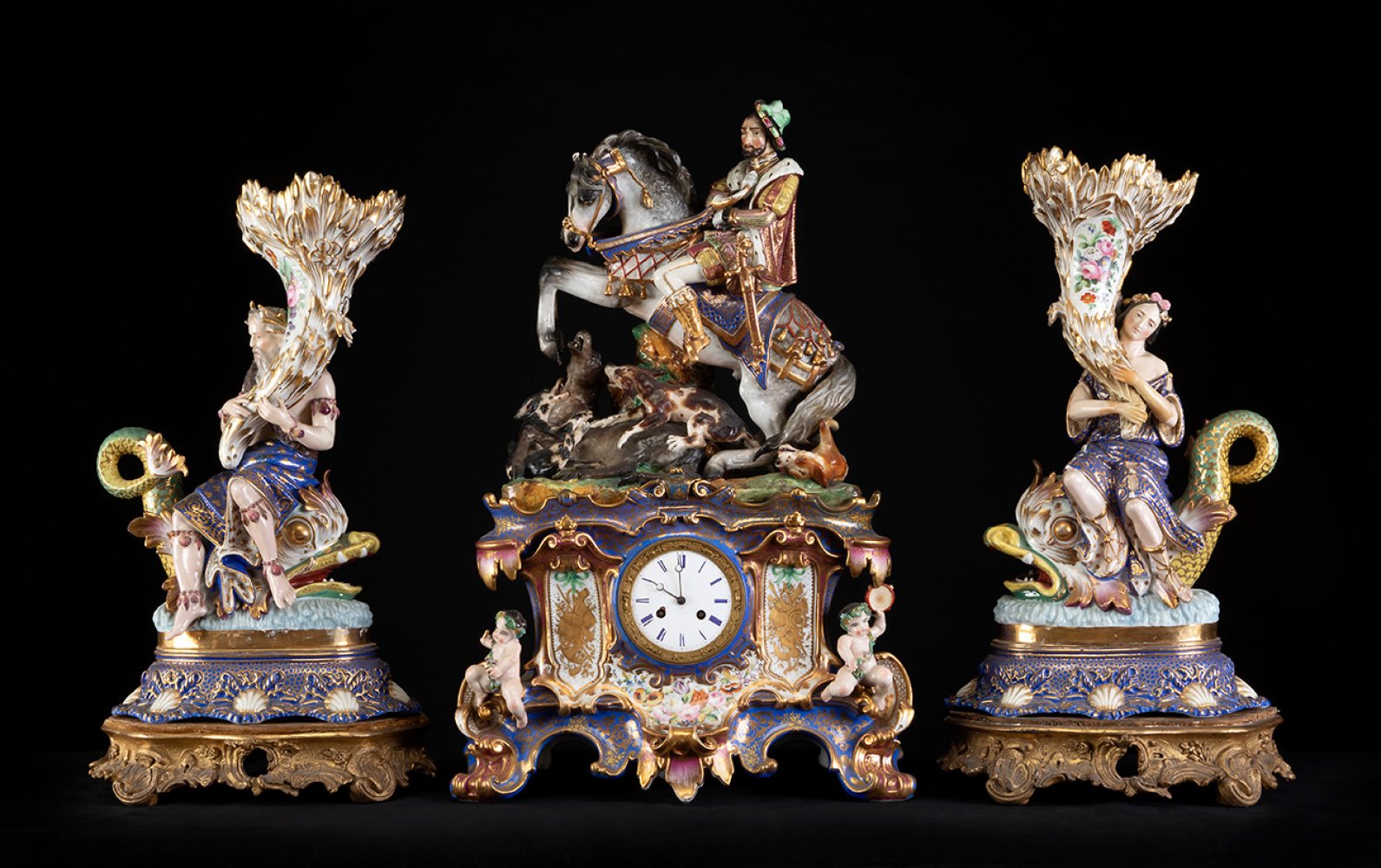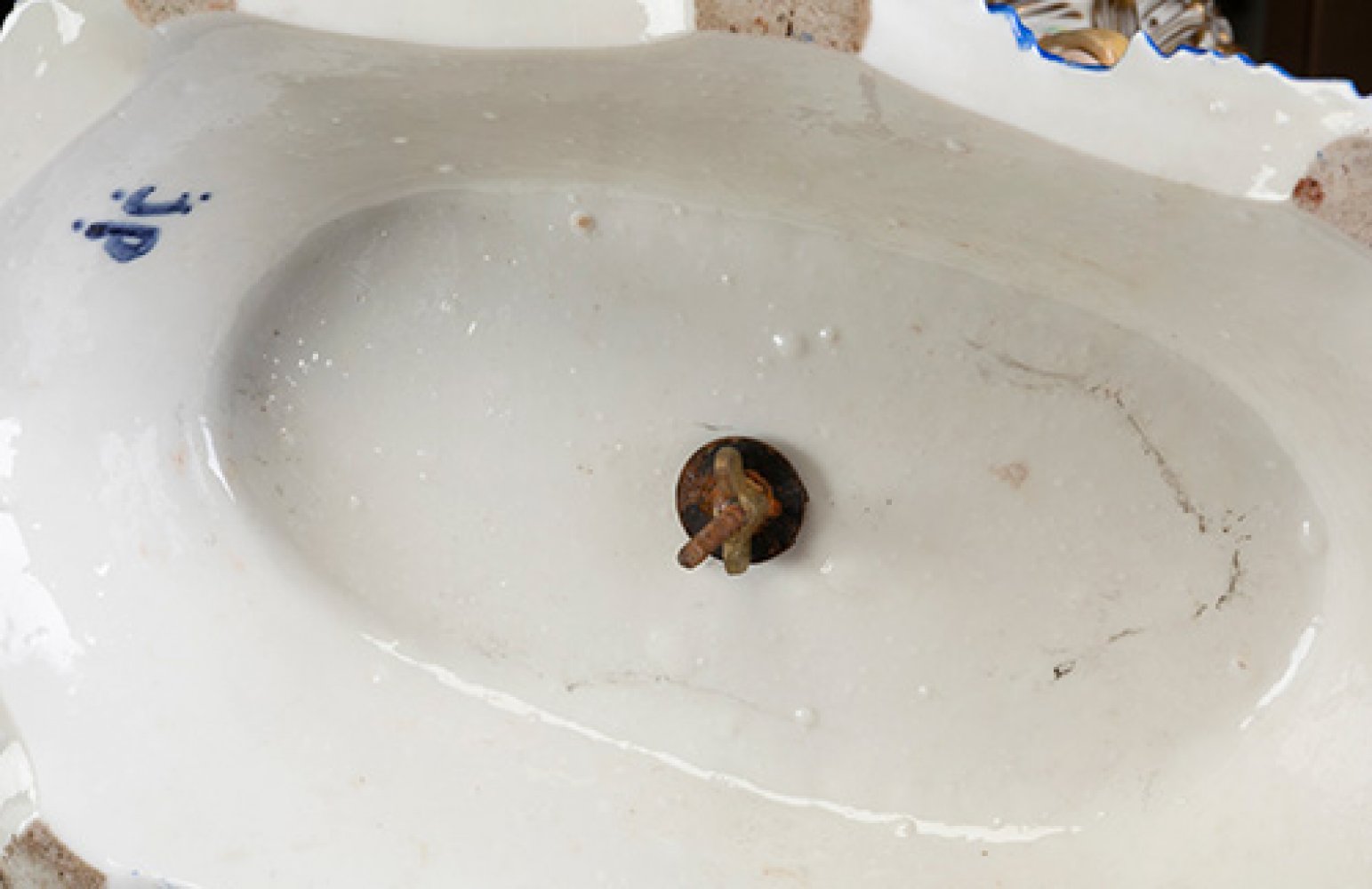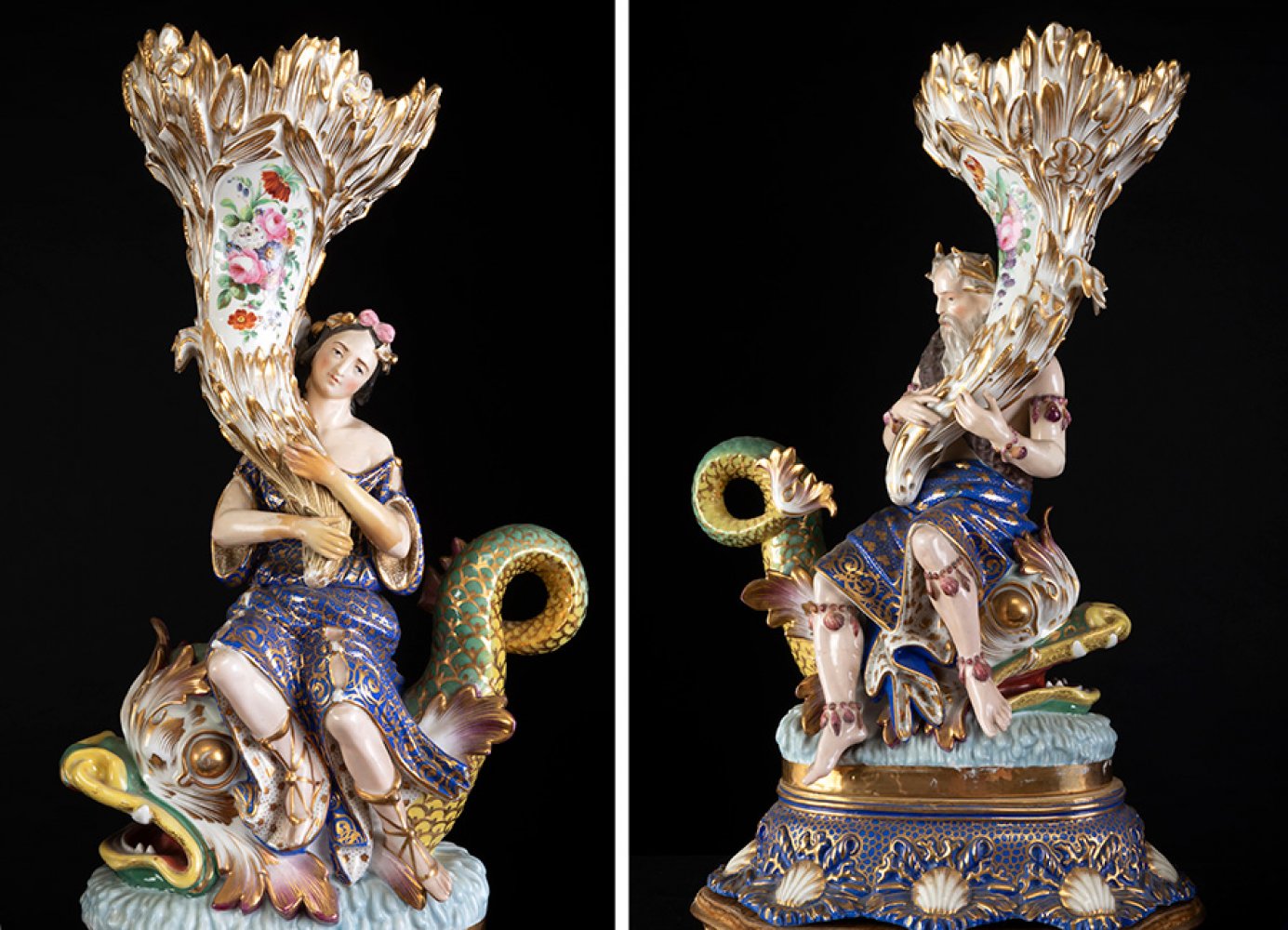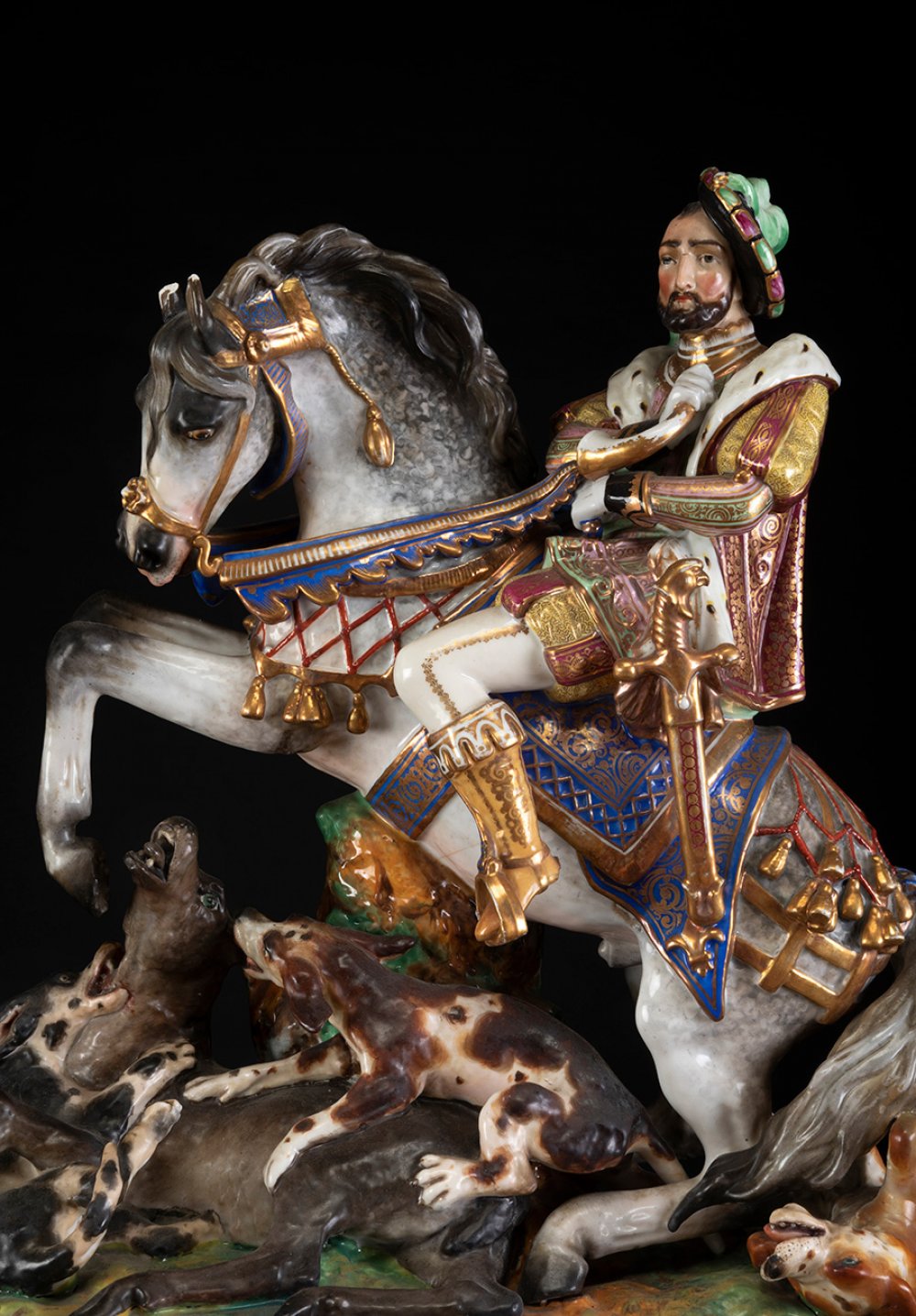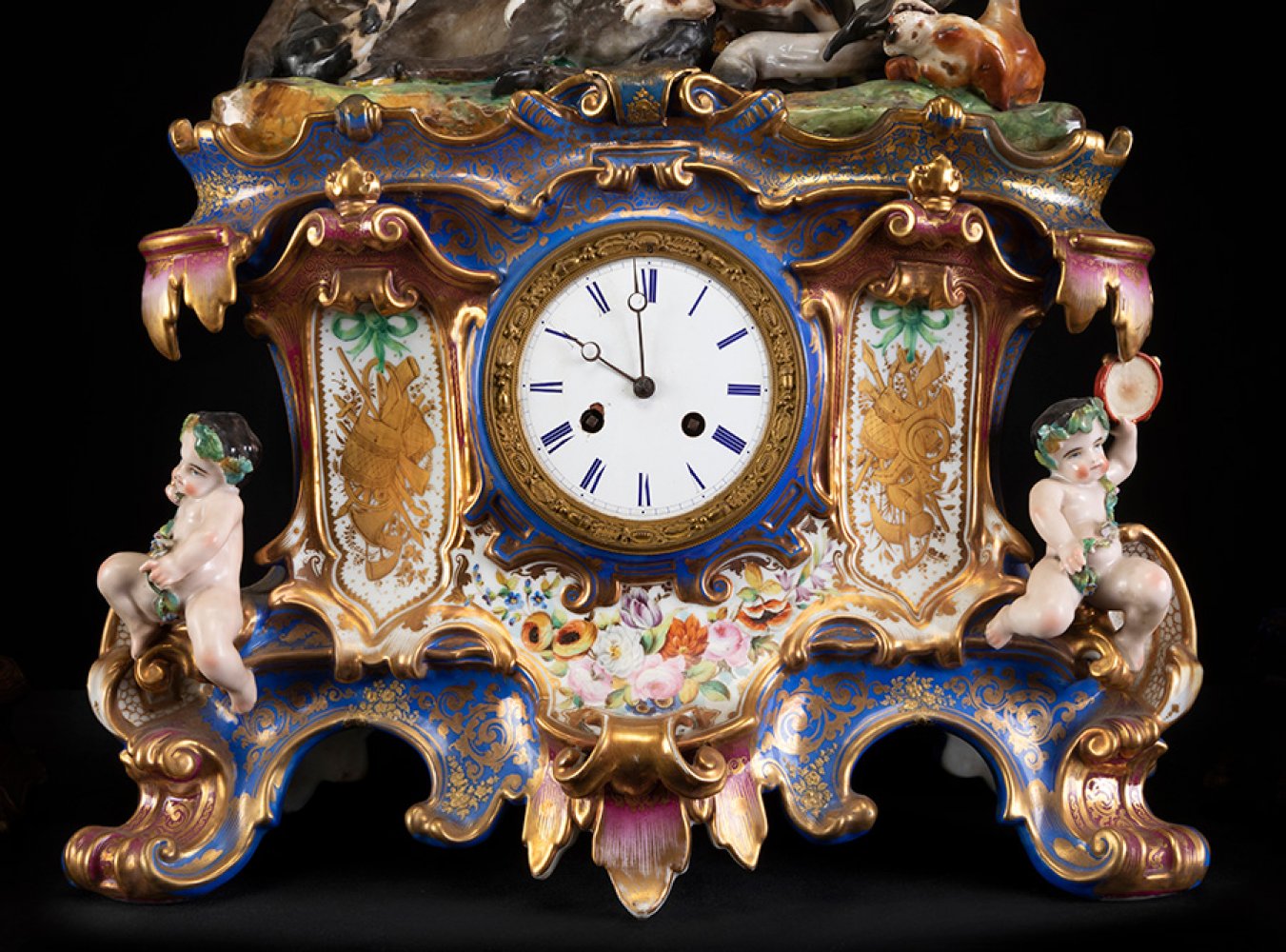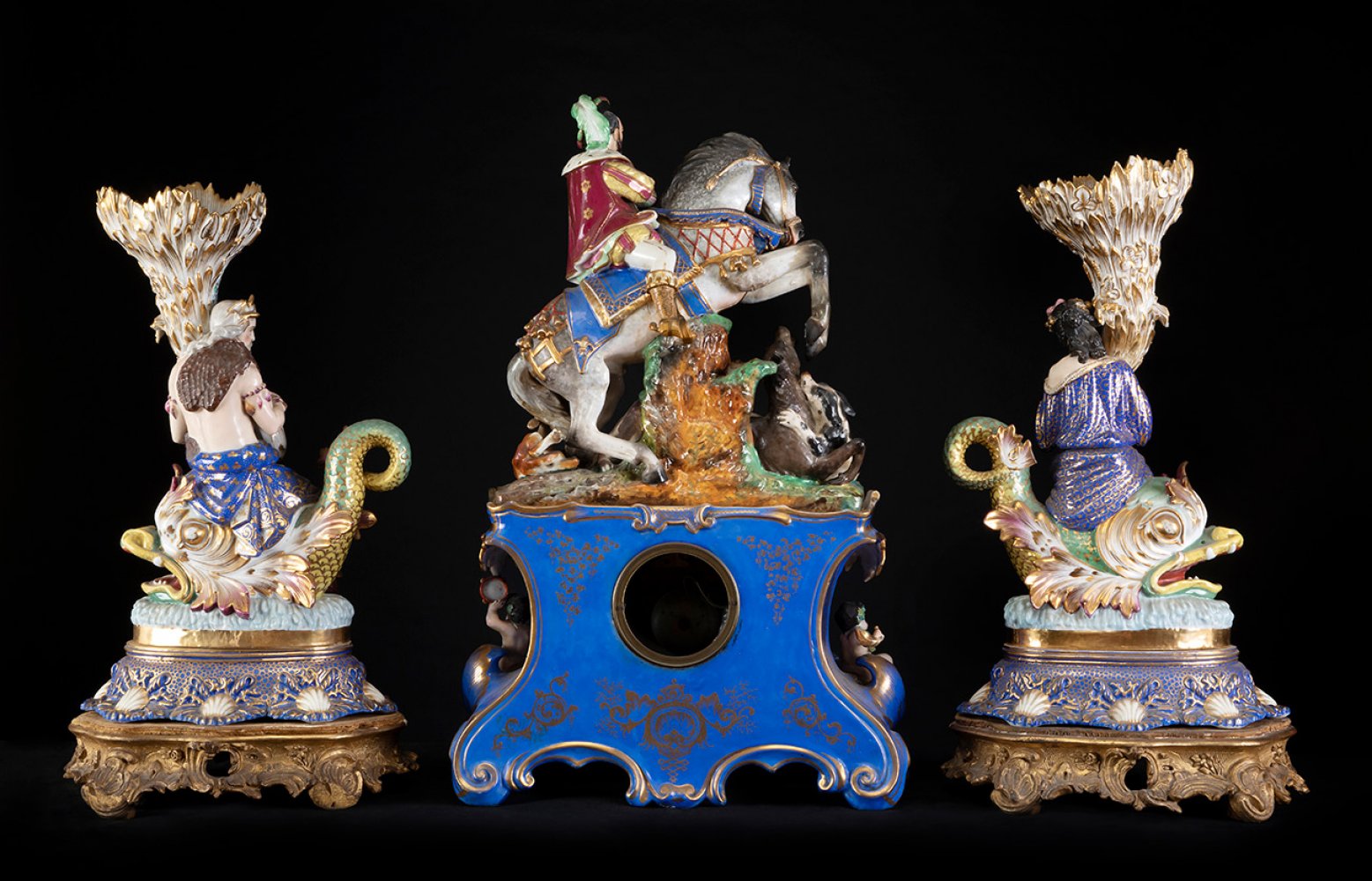90
JACOB PETIT (France, 1796-1865).Garnish, mid-19th century.Enamelled porcelain.This piece was
1/7
Descrizione
JACOB PETIT (France, 1796-1865).
Garnish, mid-19th century.
Enamelled porcelain.
This piece was commissioned by Eugénie de Montijo from Jacob Petit as a gift to her husband Napoleon III.
Signed with initials "J.P." on the base.
It has small restorations.
Measurements: 74 x 50 x 21 cm (clock); 67 x 36 x 28 cm (garnish with stand).
The harness was commissioned from Petit by the French Empress, Eugénie de Montijo. Hence the dominant imperial iconography, with the equestrian figure of François I, the Renaissance king remembered as a great patron of the arts, decorating the central piece. The garnitures consist of sculptures inspired by sea divinities from the Olympian pantheon. They depict, respectively, Poseidon and Amphitrite bearing horns of plenty, seated on tritons. Each sculptural piece (the French king, the pack of dogs, the pair of gods, the putti, etc.) has been worked in detail, reproducing each element of the clothing and anatomy with meticulous attention to detail, as was characteristic of the work of this great porcelain master. The clock is numbered in Roman numerals.
Jacob Petit (1796-1865) was one of the most famous porcelain artists of the 19th century. After travelling extensively in Europe, he returned to France and established a modest porcelain manufactory in Sèvres in 1830. As his business expanded, he moved to a rented factory in Fontainebleau in 1834 and by 1838 was offering highly prized ornamental objects to a distinguished clientele. His work was an innovative fusion of neoclassical, rococo and romantic elements that blended complex motifs and sculptural forms using a lively and distinctive palette. He is generally credited with introducing Rococo into Parisian porcelain production in 1834, which was a radical departure from the prevailing neoclassical fashion.
Garnish, mid-19th century.
Enamelled porcelain.
This piece was commissioned by Eugénie de Montijo from Jacob Petit as a gift to her husband Napoleon III.
Signed with initials "J.P." on the base.
It has small restorations.
Measurements: 74 x 50 x 21 cm (clock); 67 x 36 x 28 cm (garnish with stand).
The harness was commissioned from Petit by the French Empress, Eugénie de Montijo. Hence the dominant imperial iconography, with the equestrian figure of François I, the Renaissance king remembered as a great patron of the arts, decorating the central piece. The garnitures consist of sculptures inspired by sea divinities from the Olympian pantheon. They depict, respectively, Poseidon and Amphitrite bearing horns of plenty, seated on tritons. Each sculptural piece (the French king, the pack of dogs, the pair of gods, the putti, etc.) has been worked in detail, reproducing each element of the clothing and anatomy with meticulous attention to detail, as was characteristic of the work of this great porcelain master. The clock is numbered in Roman numerals.
Jacob Petit (1796-1865) was one of the most famous porcelain artists of the 19th century. After travelling extensively in Europe, he returned to France and established a modest porcelain manufactory in Sèvres in 1830. As his business expanded, he moved to a rented factory in Fontainebleau in 1834 and by 1838 was offering highly prized ornamental objects to a distinguished clientele. His work was an innovative fusion of neoclassical, rococo and romantic elements that blended complex motifs and sculptural forms using a lively and distinctive palette. He is generally credited with introducing Rococo into Parisian porcelain production in 1834, which was a radical departure from the prevailing neoclassical fashion.
Auction Details
Spedizione
T&Cs & Important Info
Ask seller a question
JACOB PETIT (France, 1796-1865).
Garnish, mid-19th century.
Enamelled porcelain.
This piece was commissioned by Eugénie de Montijo from Jacob Petit as a gift to her husband Napoleon III.
Signed with initials "J.P." on the base.
It has small restorations.
Measurements: 74 x 50 x 21 cm (clock); 67 x 36 x 28 cm (garnish with stand).
The harness was commissioned from Petit by the French Empress, Eugénie de Montijo. Hence the dominant imperial iconography, with the equestrian figure of François I, the Renaissance king remembered as a great patron of the arts, decorating the central piece. The garnitures consist of sculptures inspired by sea divinities from the Olympian pantheon. They depict, respectively, Poseidon and Amphitrite bearing horns of plenty, seated on tritons. Each sculptural piece (the French king, the pack of dogs, the pair of gods, the putti, etc.) has been worked in detail, reproducing each element of the clothing and anatomy with meticulous attention to detail, as was characteristic of the work of this great porcelain master. The clock is numbered in Roman numerals.
Jacob Petit (1796-1865) was one of the most famous porcelain artists of the 19th century. After travelling extensively in Europe, he returned to France and established a modest porcelain manufactory in Sèvres in 1830. As his business expanded, he moved to a rented factory in Fontainebleau in 1834 and by 1838 was offering highly prized ornamental objects to a distinguished clientele. His work was an innovative fusion of neoclassical, rococo and romantic elements that blended complex motifs and sculptural forms using a lively and distinctive palette. He is generally credited with introducing Rococo into Parisian porcelain production in 1834, which was a radical departure from the prevailing neoclassical fashion.
Garnish, mid-19th century.
Enamelled porcelain.
This piece was commissioned by Eugénie de Montijo from Jacob Petit as a gift to her husband Napoleon III.
Signed with initials "J.P." on the base.
It has small restorations.
Measurements: 74 x 50 x 21 cm (clock); 67 x 36 x 28 cm (garnish with stand).
The harness was commissioned from Petit by the French Empress, Eugénie de Montijo. Hence the dominant imperial iconography, with the equestrian figure of François I, the Renaissance king remembered as a great patron of the arts, decorating the central piece. The garnitures consist of sculptures inspired by sea divinities from the Olympian pantheon. They depict, respectively, Poseidon and Amphitrite bearing horns of plenty, seated on tritons. Each sculptural piece (the French king, the pack of dogs, the pair of gods, the putti, etc.) has been worked in detail, reproducing each element of the clothing and anatomy with meticulous attention to detail, as was characteristic of the work of this great porcelain master. The clock is numbered in Roman numerals.
Jacob Petit (1796-1865) was one of the most famous porcelain artists of the 19th century. After travelling extensively in Europe, he returned to France and established a modest porcelain manufactory in Sèvres in 1830. As his business expanded, he moved to a rented factory in Fontainebleau in 1834 and by 1838 was offering highly prized ornamental objects to a distinguished clientele. His work was an innovative fusion of neoclassical, rococo and romantic elements that blended complex motifs and sculptural forms using a lively and distinctive palette. He is generally credited with introducing Rococo into Parisian porcelain production in 1834, which was a radical departure from the prevailing neoclassical fashion.
26th July - Decorative Arts
Sale Date(s)
Indirizzo della sede
Aragón 346, Barcelona
Calle Velázquez 7, Madrid
Carrer de Cirilo Amorós 55, Valencia
Barcelona
08009
Spain
General delivery information available from the auctioneer
Setdart offers Worldwide shipping
PICK UP IN ROOM: You can come and pick up your lots in our offices (Barcelona, Madrid or Valencia). At the moment of the withdrawal, you will be able to accept the current conditions of the lot by means of a document that you will sign.
YOU CAN SEND ANOTHER PERSON TO PICK UP: This person must present a signed authorization that you can find in our web page by accessing from BUY AT SETDART- LOGISTICS-DOWNLOAD AUTHORIZATION DOCUMENT. You can also send an e-mail with the requested data in AUTHORIZATION DOCUMENT to admin@setdart.com
Informazioni importanti
25% buyer´s premium
21% buyer´s premium at www.setdart.com















